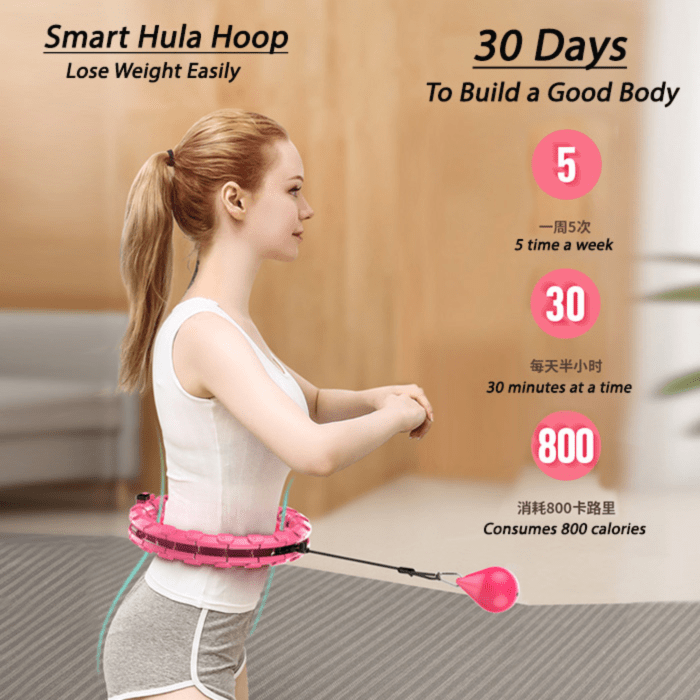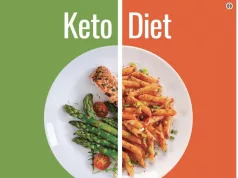Can you lose weight with hula hoop? It’s a question many people ask, intrigued by the idea of a fun and engaging workout. While hula hooping alone might not be a magic weight loss solution, it can certainly be a valuable tool in your fitness journey. Hula hooping is a full-body workout that engages multiple muscle groups, particularly in the core, legs, and arms. This rhythmic exercise not only burns calories but also improves balance, coordination, and flexibility.
This article explores the potential of hula hooping for weight loss, delving into its calorie-burning potential, muscle engagement, and the importance of incorporating it into a comprehensive fitness plan. We’ll also discuss different types of hula hoops, proper techniques, and tips for making hula hooping a fun and motivating part of your routine.
Hula Hooping and Calorie Burn

Hula hooping is a fun and engaging exercise that can provide a great cardiovascular workout. The calorie burn potential of hula hooping depends on various factors, including the duration, intensity, and individual’s fitness level.
Calorie Burn Potential
The number of calories burned while hula hooping varies based on the intensity and duration of the workout. A vigorous hula hooping session can burn a significant number of calories, comparable to other moderate-intensity exercises like jogging or swimming.
- A beginner who hula hoops for 30 minutes at a moderate pace can burn around 150-200 calories.
- An experienced hula hooper who engages in a high-intensity workout for an hour can burn upwards of 500 calories.
Comparison to Other Forms of Exercise
Hula hooping can be a calorie-burning activity comparable to other popular forms of exercise.
- A 30-minute hula hooping session at a moderate pace can burn similar calories to a 30-minute brisk walk.
- A high-intensity hula hooping workout can burn calories comparable to a 30-minute jog or a 30-minute swimming session.
Estimated Calories Burned per Hour
The following table provides estimated calories burned per hour for various hula hooping routines:
| Hula Hooping Routine | Estimated Calories Burned per Hour |
|---|---|
| Beginner (Moderate Pace) | 300-400 |
| Intermediate (Moderate to High Intensity) | 400-600 |
| Advanced (High Intensity) | 600-800 |
Muscle Engagement and Benefits: Can You Lose Weight With Hula Hoop
Hula hooping is not just a fun activity, it’s a workout that engages various muscle groups throughout your body, contributing to overall fitness and well-being.
Core Strength and Balance, Can you lose weight with hula hoop
Hula hooping requires you to maintain a stable core to keep the hoop moving around your waist. This constant engagement strengthens your abdominal muscles, obliques, and lower back, leading to improved core strength. The act of keeping the hoop spinning also challenges your balance, enhancing your coordination and stability.
Posture and Flexibility
Hula hooping can help improve your posture and flexibility. The repetitive movement of the hoop encourages you to maintain an upright posture, strengthening your back muscles and improving spinal alignment. The twisting and turning motions during hula hooping also promote flexibility in your spine and hips.
Hula Hooping for Weight Loss
Hula hooping can be a fun and effective way to incorporate exercise into your daily routine and contribute to your weight loss goals. While it’s not a magic solution, when combined with a balanced diet and other forms of physical activity, it can play a valuable role in your weight management journey.
Hula Hooping as Part of a Comprehensive Weight Loss Program
Hula hooping can be a fun and effective way to incorporate exercise into your daily routine and contribute to your weight loss goals. While it’s not a magic solution, when combined with a balanced diet and other forms of physical activity, it can play a valuable role in your weight management journey.
- Calorie Burning: Hula hooping can burn a significant number of calories, depending on the intensity and duration of your workout. A 30-minute hula hooping session can burn around 200-400 calories, similar to other moderate-intensity exercises like jogging or swimming.
- Cardiovascular Health: Hula hooping is a great cardiovascular workout that elevates your heart rate and improves blood circulation. This can contribute to overall heart health and reduce the risk of cardiovascular diseases.
- Muscle Engagement: Hula hooping engages various muscle groups, including your core, legs, and arms. This helps to strengthen and tone your muscles, contributing to a more sculpted physique.
The Role of Diet and Other Exercise Activities
While hula hooping can contribute to weight loss, it’s crucial to remember that it’s just one part of a comprehensive weight loss program. A balanced diet and other forms of exercise are equally important.
- Balanced Diet: A healthy diet plays a crucial role in weight management. Focus on consuming whole, unprocessed foods, such as fruits, vegetables, lean proteins, and whole grains. Limit your intake of processed foods, sugary drinks, and unhealthy fats.
- Other Exercise Activities: Incorporate other forms of exercise into your routine, such as cardio (running, cycling, swimming), strength training (weightlifting, bodyweight exercises), and flexibility exercises (yoga, Pilates). This provides a well-rounded approach to fitness and helps to prevent plateaus.
Consistency and Realistic Expectations
Consistency is key to achieving sustainable weight loss through hula hooping. Aim for regular sessions, even if they’re shorter in duration.
- Set Realistic Goals: Don’t expect to lose weight overnight. Weight loss is a gradual process that requires patience and consistency. Set realistic goals and celebrate your progress along the way.
- Listen to Your Body: If you’re new to hula hooping, start slowly and gradually increase the intensity and duration of your workouts. Listen to your body and take breaks when needed.
- Enjoy the Process: Hula hooping should be enjoyable. If you’re not enjoying it, you’re less likely to stick with it. Find ways to make it fun, such as listening to music or working out with a friend.
Types of Hula Hoops and Their Impact
Choosing the right hula hoop can significantly impact your workout experience and weight loss journey. Different types of hoops cater to varying fitness levels, goals, and preferences. Understanding the pros and cons of each type can help you select the most effective and enjoyable hoop for your needs.
Types of Hula Hoops and Their Features
Different hula hoops offer unique features and benefits, making them suitable for various purposes and fitness levels.
- Regular Hula Hoops: These are the most basic and affordable type, typically made from plastic or lightweight materials. They are ideal for beginners and those looking for a fun and low-impact workout. Regular hoops are easy to learn and maneuver, providing a gentle introduction to hula hooping.
- Weighted Hula Hoops: Weighted hoops are heavier than regular hoops, typically made with added weight or a denser material. They require more effort to spin and provide a more intense workout. Weighted hoops are great for building core strength, improving balance, and burning more calories.
- Smart Hula Hoops: Smart hoops incorporate technology to enhance your workout experience. These hoops often include features like built-in calorie counters, heart rate monitors, and workout trackers. Smart hoops can provide valuable data and motivation to help you reach your fitness goals.
Comparison of Hula Hoop Types for Weight Loss
The effectiveness of different hula hoop types for weight loss depends on factors such as exercise intensity, duration, and individual fitness levels.
- Regular Hula Hoops: While regular hoops can contribute to calorie burning, they might not be as effective for weight loss as weighted hoops. Their lighter weight generally leads to less resistance and a lower calorie burn.
- Weighted Hula Hoops: Weighted hoops offer a more intense workout due to their increased resistance. This increased intensity can lead to higher calorie expenditure and potentially faster weight loss results. However, it’s crucial to start with a hoop weight that feels comfortable and gradually increase the weight as you build strength.
- Smart Hula Hoops: Smart hoops can aid in weight loss by providing data and motivation. They track your workout progress, calorie burn, and heart rate, helping you stay accountable and make informed decisions about your fitness routine.
Pros and Cons of Different Hula Hoop Types
| Hula Hoop Type | Pros | Cons |
|---|---|---|
| Regular Hula Hoops |
|
|
| Weighted Hula Hoops |
|
|
| Smart Hula Hoops |
|
|
Recommended Uses for Different Hula Hoop Types
- Regular Hula Hoops: Ideal for beginners, low-impact workouts, and fun fitness activities.
- Weighted Hula Hoops: Suitable for intermediate to advanced fitness levels, building core strength, and increasing calorie expenditure.
- Smart Hula Hoops: Recommended for individuals seeking data-driven fitness tracking, motivation, and personalized workout guidance.
Hula Hooping Techniques and Safety
Hula hooping is a fun and effective way to exercise, but it’s essential to learn the proper techniques and safety precautions to avoid injuries. Mastering the art of hula hooping requires patience, practice, and a focus on form. By understanding the fundamentals and common mistakes to avoid, you can enhance your experience and reap the benefits of this engaging activity.
Learning to Hula Hoop: A Step-by-Step Guide for Beginners
Learning to hula hoop effectively and safely involves a gradual process that begins with mastering the basic technique and then progresses to more advanced moves.
- Choose the Right Hoop: The size of your hoop is crucial for beginners. A larger hoop is easier to learn with as it provides more time for your body to adjust to the movement.
- Start with the Basic Spin: Stand with your feet shoulder-width apart and hold the hoop in front of you. Begin by rotating the hoop around your waist, starting with a gentle push and maintaining a consistent pace.
- Engage Your Core: As you spin the hoop, engage your core muscles to maintain balance and control. This will help you keep the hoop moving smoothly and prevent it from falling.
- Find Your Rhythm: Pay attention to the rhythm of the hoop’s movement. As you become more comfortable, try increasing the speed and intensity of your spins.
- Practice Regularly: Consistent practice is key to mastering hula hooping. Start with short sessions and gradually increase the duration as you improve.
Proper Form and Technique for Maximum Calorie Burn and Injury Prevention
Proper form and technique are essential for maximizing calorie burn and minimizing the risk of injury.
- Maintain a Straight Back: Avoid hunching over or bending your back, as this can strain your spine and reduce the effectiveness of your workout.
- Engage Your Core: As mentioned earlier, a strong core is crucial for stability and control. Engage your abdominal muscles to support your back and prevent injury.
- Keep Your Head Up: Look straight ahead and maintain good posture. Avoid looking down at your feet, as this can throw off your balance.
- Use Your Hips: Use your hips to rotate the hoop, not just your arms. This will help you achieve a smooth and continuous spin.
- Maintain a Consistent Pace: Keep the hoop moving at a steady pace. Avoid sudden changes in speed, as this can cause the hoop to fall or lead to injury.
Common Mistakes to Avoid and How to Correct Them
Understanding common mistakes and how to correct them is essential for safe and effective hula hooping.
- Hoop Falling: If the hoop falls, it’s likely due to a lack of core engagement or improper technique. Practice engaging your core muscles and maintaining a consistent pace to prevent this.
- Pain in Your Back or Hips: Pain in these areas can be caused by poor posture or overexertion. Ensure you’re maintaining a straight back and using proper technique. Gradually increase the duration of your workouts to avoid overexertion.
- Hoop Hitting Your Body: If the hoop hits your body, it’s likely due to a lack of control or an incorrect hoop size. Practice maintaining a consistent pace and choose a hoop that fits your body comfortably.
- Feeling Dizzy or Lightheaded: Dizziness or lightheadedness can occur due to dehydration or overexertion. Stay hydrated and gradually increase the intensity of your workouts.
Hula Hooping for Fun and Motivation
Hula hooping is more than just a childhood pastime; it can be a fun and engaging form of exercise that promotes motivation and enjoyment. Unlike some traditional workouts, hula hooping offers a playful approach to fitness, making it easier to stick with and achieve your fitness goals.
Incorporating Hula Hooping into a Fitness Routine
Hula hooping can easily be integrated into your existing fitness routine, adding variety and excitement. Here are some creative ways to incorporate it:
- Warm-up: Start your workout with a few minutes of hula hooping to get your blood flowing and muscles warmed up.
- Cardio Blast: Include a dedicated hula hooping session for a high-energy cardio workout.
- Cool-down: Hula hooping can be a fun and gentle way to cool down after a more intense workout.
- Interval Training: Alternate between hula hooping and other exercises like jogging or jumping jacks for an effective interval workout.
- Strength Training: Hula hooping can be combined with strength training exercises, such as squats or lunges, for a full-body workout.
Making Hula Hooping a Social Activity
Hula hooping can be a social activity, creating a fun and engaging experience for you and your friends.
- Group Hula Hooping Sessions: Organize group hula hooping sessions in parks, community centers, or even your own backyard. This can be a great way to connect with friends and motivate each other.
- Hula Hooping Parties: Host a hula hooping party with themed music, snacks, and hula hooping games. This can be a fun way to celebrate special occasions or just enjoy some time with friends.
- Hula Hooping Classes: Look for local hula hooping classes or workshops. These classes can teach you new techniques, tricks, and routines, while providing a social environment for learning and sharing your passion.
Incorporating Hula Hooping into Group Fitness Classes
Hula hooping can be incorporated into group fitness classes to add a fun and engaging element.
- Zumba or Dance Fitness: Hula hooping can be incorporated into Zumba or other dance fitness classes to add a unique and challenging element.
- Bootcamp Classes: Hula hooping can be included as a station in bootcamp classes, providing a high-energy cardio burst.
- Yoga or Pilates: Hula hooping can be used as a warm-up or cool-down in yoga or Pilates classes, helping to improve flexibility and coordination.
Concluding Remarks
Ultimately, whether you can lose weight with hula hooping depends on various factors, including your diet, overall exercise regimen, and individual goals. While it’s not a shortcut to weight loss, hula hooping can be a fun and effective way to boost your calorie burn, improve your fitness, and enhance your overall well-being. So, grab a hula hoop, put on some music, and get ready to twirl your way to a healthier lifestyle!
User Queries
What kind of hula hoop is best for weight loss?
Weighted hula hoops are generally considered more effective for weight loss as they provide more resistance and engage muscles more intensely.
How often should I hula hoop to see results?
Aim for at least 30 minutes of hula hooping, 3-4 times a week, for optimal results. Consistency is key.
Can hula hooping help with belly fat?
While hula hooping can strengthen core muscles, it’s not a targeted solution for belly fat. A balanced diet and overall exercise routine are essential for reducing belly fat.
Is hula hooping safe for everyone?
Hula hooping is generally safe, but it’s important to start slowly, use proper form, and listen to your body. If you have any health concerns, consult with your doctor before starting any new exercise program.
Hula hooping can be a fun way to burn calories and tone your core, but it’s important to remember that it’s just one part of a healthy lifestyle. To see real results, you’ll need to combine it with a balanced diet and regular exercise.
Speaking of diet, it’s always handy to know how long foods last in the freezer, like this handy guide , so you can make sure you’re not wasting any food while you’re working towards your fitness goals.
While hula hooping can be a fun way to burn calories, it’s important to remember that it’s just one piece of the puzzle when it comes to weight loss. Combining it with a healthy diet is crucial, and a simple recipe to consider is how to make diet cabbage soup.
This light and flavorful soup can be a great addition to your weight loss journey, helping you feel full and satisfied while keeping your calorie intake in check. Remember, consistency is key, so stick with your hula hoop routine and healthy eating plan for optimal results.
While hula hooping can definitely contribute to calorie burning and help you shed some pounds, it’s important to remember that a balanced diet plays a crucial role in weight loss. To ensure your body gets the necessary nutrients and promotes healthy digestion, consider checking out this resource on how much dietary fiber per day.
Remember, incorporating a healthy diet along with your hula hoop workouts can help you achieve your weight loss goals more effectively.
























